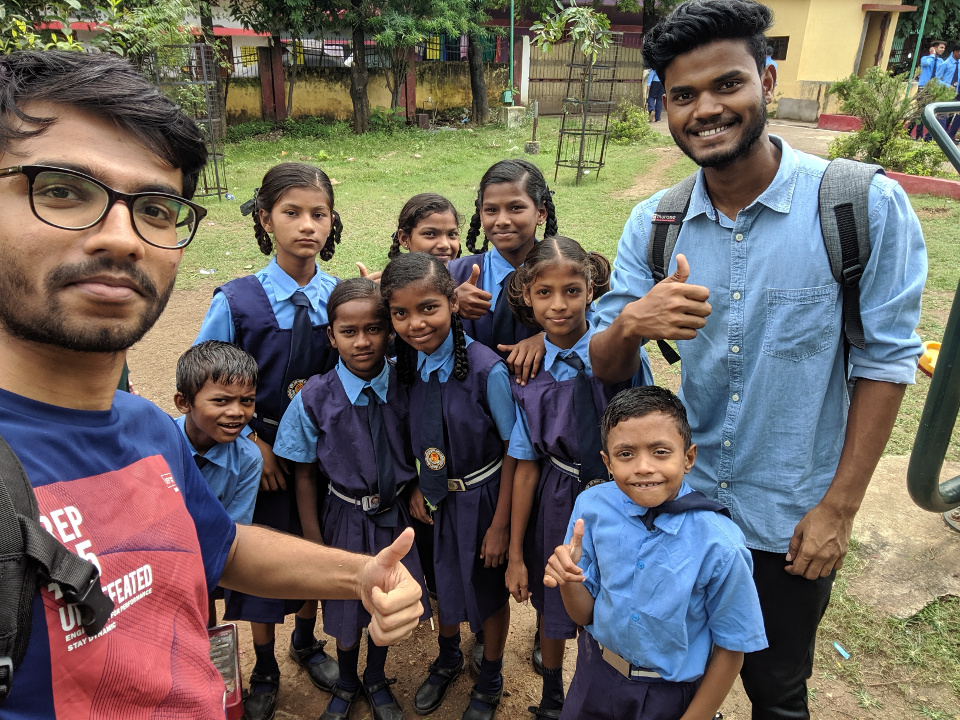At times we are so occupied in our lives that we forget to be grateful about the small thing that we have/can do, they start to matter less. The simple joy of being able to see the beautiful world around us or to just listen to the rain falling in the Monsoon season (This year the rain’s been very unpredictable in Raipur) or the sweet smell of the wet dirt drifting through the winds (The petrichor: मिट्टी की सौंधी सौंधी खुशबू ). We at times are blind to these and are worried about what we don’t have and run behind things that we don’t need but want.
In this world that we live in, we forget that there are some brave souls that live in the same world but where everything is dark or everything is quiet. We - Pradeep Kumar and I decided to visit “Government Higher Secondary School for Blind and Deafmute, Raipur” as part of a Psychology Project which turned out to be an enlightening experience for both of us.
It was not that hard to find the place, a bit of a search on Google Maps and a bit of asking around, we were there: a place that looked just like a normal school. I in fact after entering the gate rechecked the banner to ensure we were at the right place. When we entered the place, there were 2 buildings: on our left was what we came to know about later - the hostel and on the right was the school. Cluelessly we marched towards the right building following a blind student who probably didn’t know that he was showing us the way.
When we were just in front of the gate of the school of blind and deaf-mute, I was transported back to my own earlier days of studying in a government school. The sounds were the same as the government school I used to study in. But the rest was different at the same time fascinating. I asked Pradeep to call the point of contact given to us by our professor who was going to help us carry out our studies. He asked us to wait for some time in the main hall.
The main hall was large, standing and waiting, we were looking around restlessly to absorb everything we saw. There was an idol of goddess Saraswati and a set of table-chairs placed in a circular manner at the extreme right corner of the main hall. At the head of this circular arrangement the teacher was sitting. The students she was teaching were blind, the most astonishing fact was that the teacher herself was blind.
The main hall had 2 wing entrances attached to it, the left was for deaf-mute students and the right one was for the blind. We had been waiting for some time and decided to sit on a nearby waiting chair.
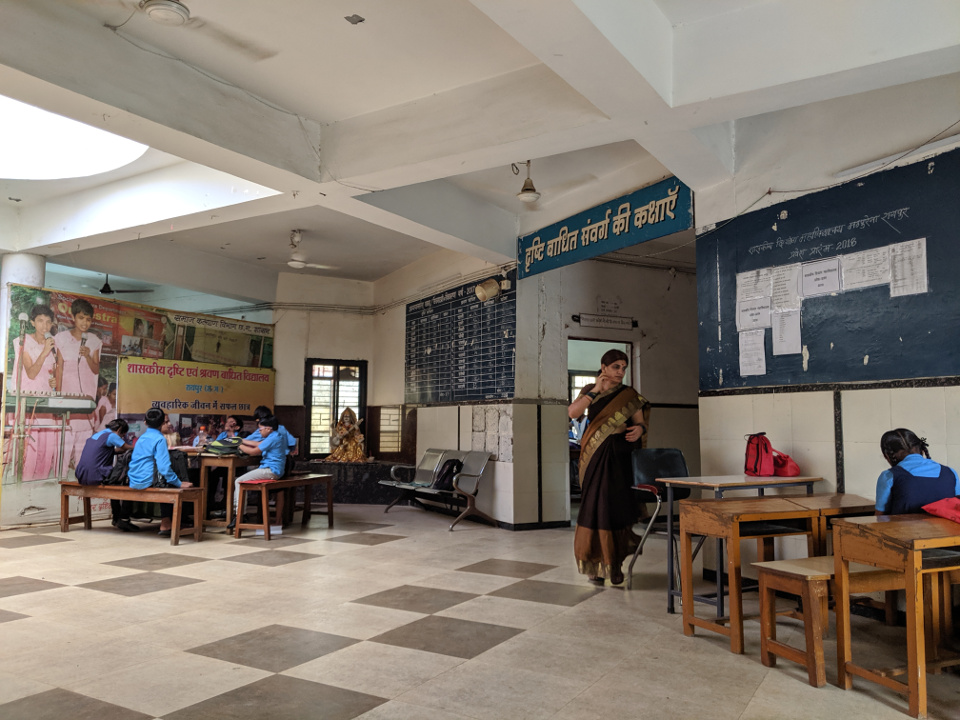
While waiting there, a middle aged man appeared to come from the same path we had come and entered the main hall. His eyes were all closed and it felt as if he was squeezing them to shut them close,he was walking with such an authority that I was awe-struck that even though being visually challenged he was walking as if he could see, but there was something very peculiar about an object in his hand, it was a set of keys. He was constantly moving them to make some sound. I had only seen this on television but I am pretty sure that he was using the echoes to determine the direction to move in and prevent obstacles.
Already intrigued by what I was seeing, be it the library for the blind or the students even though being blind talking to each other and playing like any other normal kid. It was already time for us to proceed with our study.
Our point of contact, Mr Tomeshwar Sinha, who was a very friendly person, made sure everything was arranged in the best way possible in such a setting. He asked some of the blind students to assemble in another room in the deaf-mute wing. Now you may wonder how will the blind move in a group to a completely different wing?: (I also noticed that none of the students were carrying a guiding stick.) It was a train of blind students headed by a blind student that did the trick.
We were all set in a few minutes, every one was there in the class we had been assigned in the deaf-mute wing which was remarkably silent. The students were chit chatting continuously but in sign language. The wing was very quiet compared to the blind wing we were coming from. We were given one room to keep the students and another room to conduct the experiment: where we took each student one by one separately.
When Pradeep and I entered the first room(holding room), somehow they were aware of our presence,and every one stood up and wished us Good Morning!. This feeling of what these students were capable of doing was amazing to me but there was a lot more I was going to discover in the next 5 hours I was going to spend with them.
It was time for starting the experiment, I addressed everyone regarding who we were and what we were there for. The details of the experiment were concealed and were to be told individually to each student at a later stage. I took the first volunteer and started off towards the experiment room. Our professor gave us prior instruction about working with blind people and I was very careful to follow them. They were:
- To be very courteous to them
- Always speak aloud to them so that they were always aware of what was going to happen. Like : “Now, I am going to hold and lift your left hand”: If you wanted to move their hands
The experiment room was a very small room and had some students in them, but there was a pin drop silence in the class. The children were chit chatting at times but with sign language. Again they rose up to greet me as I took my place in their teacher’s chair. The girl sitting in front of me was dedicatedly writing something and the rest were either staring at me or drawing on their sheets.
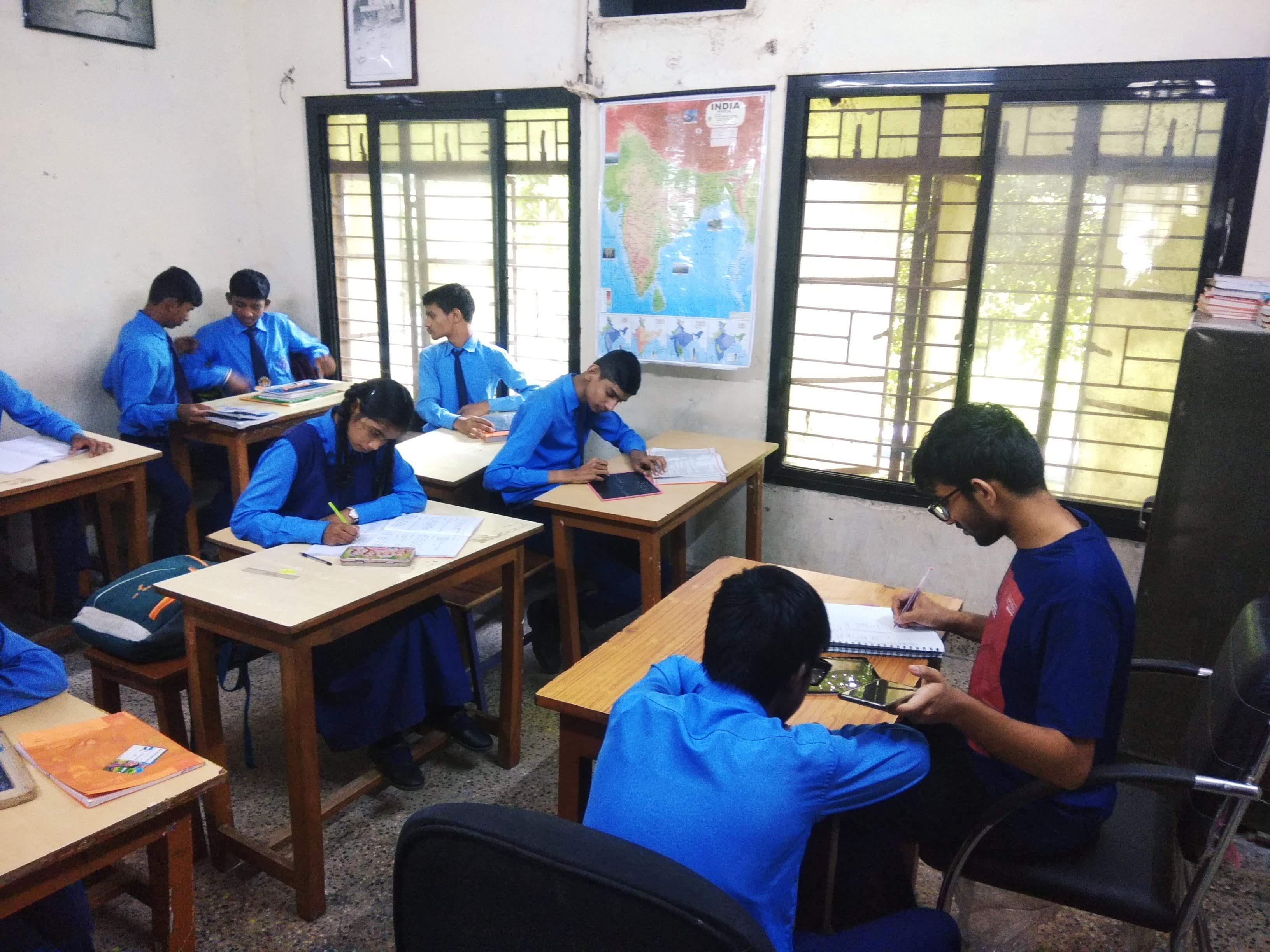
I won’t include all the proceedings of the experiments but will brief you about what we were trying to achieve.
Objective
The objective of the experiment was to understand the effect of words that produce concrete imagery vs words that are abstract in nature on the recall ability of visually impaired individuals.
Examples of the words is as follows:
| Type of words | Examples |
|---|---|
| Concrete | String, Tree, Coffee, Dress, Shoes, House, Pencil, Garden, Wheat, Potato, Woman, River, Chair, Magazine, Flower and Star. |
| Abstract | Idea, Moment, Soul, Opinion, Effort, Freedom, Series, Health, Truth, Duty, Fate, Theory, Event, Fact, Virtue and History. |
But then the students were more accustomed to Hindi so we had prepared another set of words expecting to face such a situation:
Concrete: तार फूल गेहूँ कॉफ़ी …
Abstract: सिद्धांत पल घटना गुण …
Experiments
-
There were a set of paired words each student was given to memorize (Made to listen a recording), the pair consisted of the following kind of words in equal number:
- Concrete - Concrete (CC)
- Concrete - Abstract (CA)
- Abstract - Concrete (AC)
- Abstract - Abstract (AA)
-
After making them listen to all the pairs of words once, they were given the first word of the pair and asked to recall the paired word that they remembered. The experiment was repeated 2 times on the same person (2 Trials).
The results for a normal human as per a previous experiment by Paivio’1965 are as follows that shows that the human retention capacity tends to show this order.
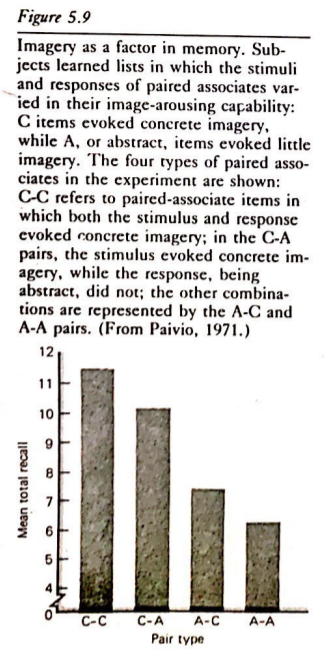
CC > CA > AC > AA
The experiment was to understand exactly what order might it be for the visually impaired individuals who could not create an imagery of concrete objects that we are accustomed to create.
The students were reluctant to sit on the seat beside me saying that it was their teacher’s position and they ought not sit there, but I persuaded them to sit. And the experiment/study started:
Everyone I interviewed for the experiment was very different:
- One girl was very shy
- One girl was very active, in fact I was astonished when she scored 100% in my tests. No one, not even a person with a vision or any of my friends could reach such a score. She wanted to become an IAS officer and with this memory she probably will.
- With some students I had a very hard time to explain what they were supposed to do. I very much understood that visual input plays a very important role in speeding up how we understand things.
- One was a cricket player and a very famous individual from Bhilai and had inaugurated a National bank, he told me all about his story and I did listen intently.
- Blind cricket he told me was very much like normal cricket except that the ball makes sound continuously. He almost taught me everything about blind cricket.
- Only arts was taught in school and almost everyone wanted to become a politician or some other government servant.
- Among the visually impaired there were many who were partially blind, but I noticed that it was the completely blind who performed very well in our memorization tests.
- Everybody loved to use computers and probably were better at typing than I am.
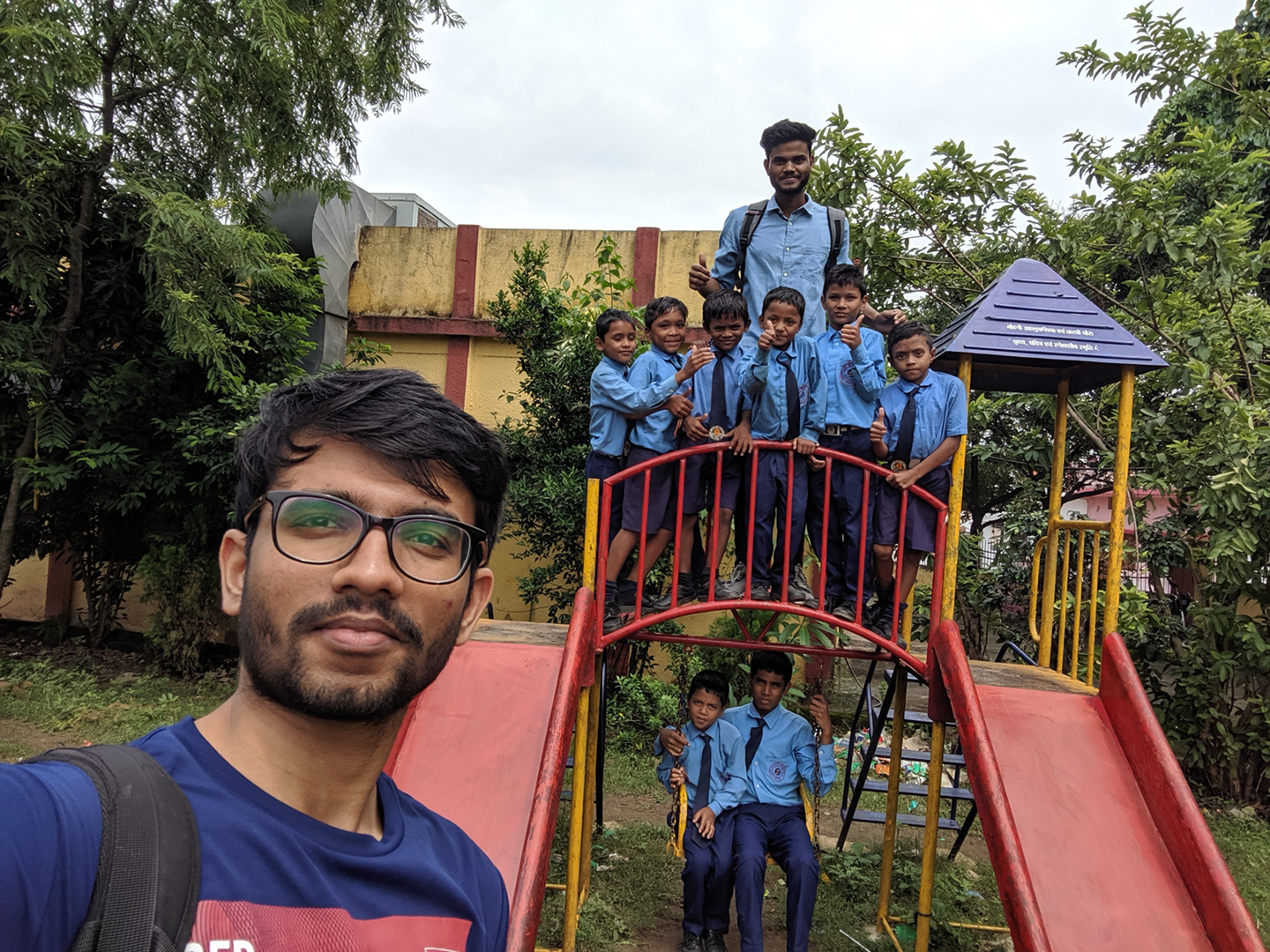
During lunch time, I had the opportunity to meet the teachers who taught there. While talking to them I learnt something very new and contradictory to my belief. I had thought that it was more difficult to teach a visually impaired person than it was to teach a deaf-mute one. But the teacher explained to me that the situation was majorly the opposite.
- The deaf-mute student had to memorize everything not knowing what was being talked about.
- The concept of dot in आनंद had to be memorized by them cause they didn’t really knew what my name sounded like.
- Explaining any contextual information like say the word “going”, needed a lot of effort to introduce to them.
- They had to completely rely on their visual memory for all the things they did.
- These things apart, the deaf-mute students were exceptionally good at drawing as can be seen here in the image and the blind were very good at music. In Fact they once performed in our college during our foundation day.
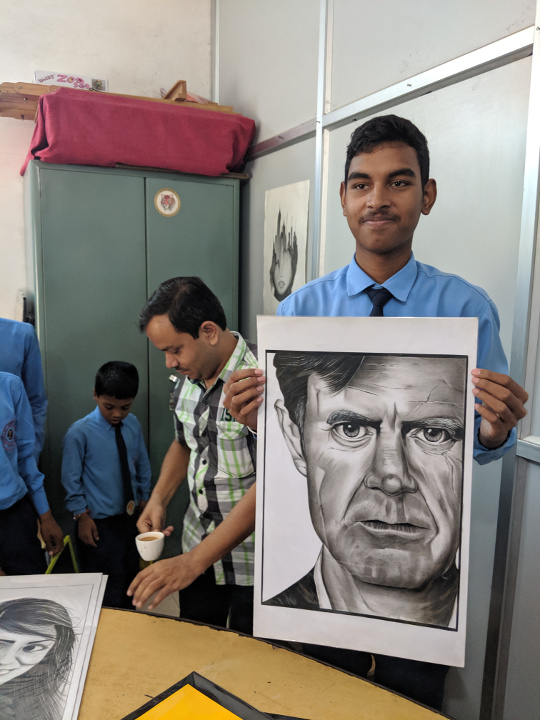
- The teacher also told us that the completely blind students tended to get distracted less often leading to better scores. (This is indeed an attempt to generalize what they saw over the years)
One of the students in fact saved my number on his mobile phone all on his own, the advancement in technology which now provides accessibility features in the phone allows these students to be connected to the world. And
their zeal to be the best was so strong that I had to question: is it ever dark enough to give up?
I do sometimes chat with this newly made friend of mine on whatsApp knowing that a computer generated voice of what I am writing is what he will be hearing, sticking his phone to his ears and a finger on his phone’s screen ready to reply.
Once the experiment was over, we bid adieu to ever friendly Mr. Sinha and the school that i will always remember. In a hurry and with a hungry stomach we left the place with a sense of happiness and with a small understanding of living in the world without light and sound.
For the results of the experiment: our psychology professor said that the findings are interesting as we could see some patterns in the obtained results. We will study them and hopefully get a better understanding of the psychology of the blind.
The author’s personal note:
The last few days have been really hectic, I was meaning to write this post like a week ago, but there were exams, presentations and form submission, thus I couldn’t get the time to finish it. The post got a bit bigger than what I had expected but hopefully conveys my feelings well. We did take permission from the authorities about taking images.
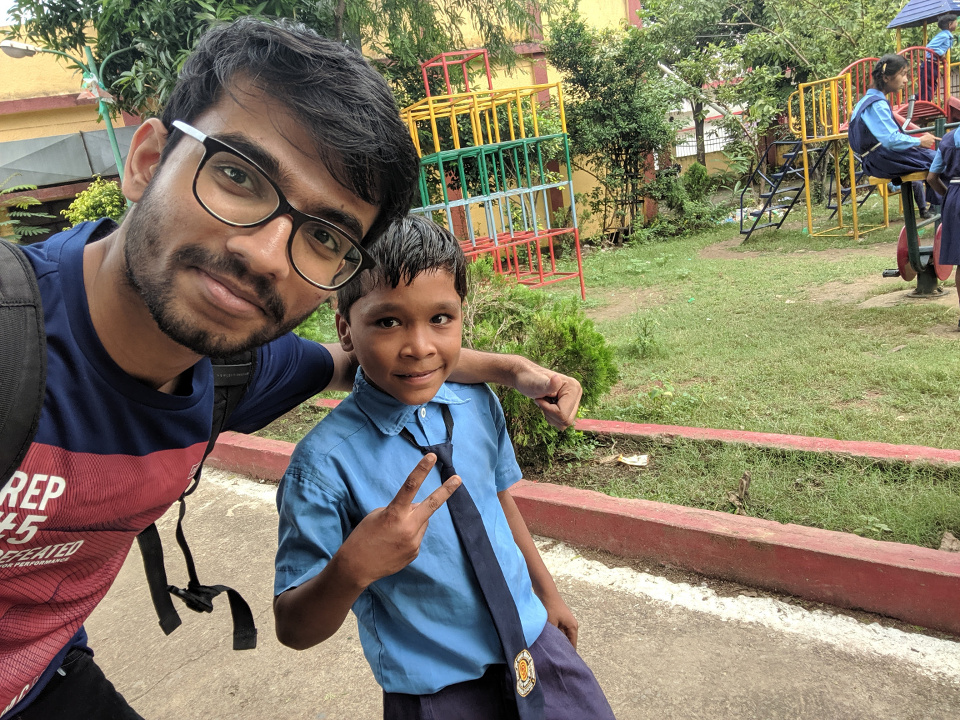 Thank you so much for reading.
Thank you so much for reading.
The comment section will be made live soon, till then you can send me your feedback on: panchbhai1969[at]gmail[dot]com.
 Anand
Anand 